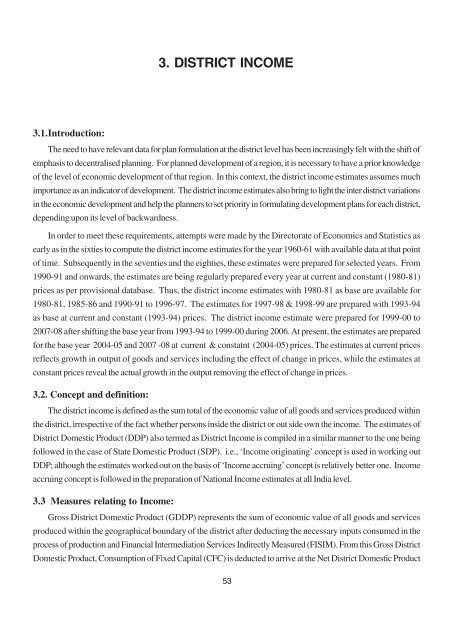Annexure - Directorate of Economics and Statistics
Annexure - Directorate of Economics and Statistics
Annexure - Directorate of Economics and Statistics
Create successful ePaper yourself
Turn your PDF publications into a flip-book with our unique Google optimized e-Paper software.
3.1.Introduction:<br />
The need to have relevant data for plan formulation at the district level has been increasingly felt with the shift <strong>of</strong><br />
emphasis to decentralised planning. For planned development <strong>of</strong> a region, it is necessary to have a prior knowledge<br />
<strong>of</strong> the level <strong>of</strong> economic development <strong>of</strong> that region. In this context, the district income estimates assumes much<br />
importance as an indicator <strong>of</strong> development. The district income estimates also bring to light the inter district variations<br />
in the economic development <strong>and</strong> help the planners to set priority in formulating development plans for each district,<br />
depending upon its level <strong>of</strong> backwardness.<br />
In order to meet these requirements, attempts were made by the <strong>Directorate</strong> <strong>of</strong> <strong>Economics</strong> <strong>and</strong> <strong>Statistics</strong> as<br />
early as in the sixties to compute the district income estimates for the year 1960-61 with available data at that point<br />
<strong>of</strong> time. Subsequently in the seventies <strong>and</strong> the eighties, these estimates were prepared for selected years. From<br />
1990-91 <strong>and</strong> onwards, the estimates are being regularly prepared every year at current <strong>and</strong> constant (1980-81)<br />
prices as per provisional database. Thus, the district income estimates with 1980-81 as base are available for<br />
1980-81, 1985-86 <strong>and</strong> 1990-91 to 1996-97. The estimates for 1997-98 & 1998-99 are prepared with 1993-94<br />
as base at current <strong>and</strong> constant (1993-94) prices. The district income estimate were prepared for 1999-00 to<br />
2007-08 after shifting the base year from 1993-94 to 1999-00 during 2006. At present, the estimates are prepared<br />
for the base year 2004-05 <strong>and</strong> 2007 -08 at current & constatnt (2004-05) prices. The estimates at current prices<br />
reflects growth in output <strong>of</strong> goods <strong>and</strong> services including the effect <strong>of</strong> change in prices, while the estimates at<br />
constant prices reveal the actual growth in the output removing the effect <strong>of</strong> change in prices.<br />
3.2. Concept <strong>and</strong> definition:<br />
The district income is defined as the sum total <strong>of</strong> the economic value <strong>of</strong> all goods <strong>and</strong> services produced within<br />
the district, irrespective <strong>of</strong> the fact whether persons inside the district or out side own the income. The estimates <strong>of</strong><br />
District Domestic Product (DDP) also termed as District Income is compiled in a similar manner to the one being<br />
followed in the case <strong>of</strong> State Domestic Product (SDP). i.e., ‘Income originating’ concept is used in working out<br />
DDP; although the estimates worked out on the basis <strong>of</strong> ‘Income accruing’ concept is relatively better one. Income<br />
accruing concept is followed in the preparation <strong>of</strong> National Income estimates at all India level.<br />
3.3 Measures relating to Income:<br />
3. DISTRICT INCOME<br />
Gross District Domestic Product (GDDP) represents the sum <strong>of</strong> economic value <strong>of</strong> all goods <strong>and</strong> services<br />
produced within the geographical boundary <strong>of</strong> the district after deducting the necessary inputs consumed in the<br />
process <strong>of</strong> production <strong>and</strong> Financial Intermediation Services Indirectly Measured (FISIM). From this Gross District<br />
Domestic Product, Consumption <strong>of</strong> Fixed Capital (CFC) is deducted to arrive at the Net District Domestic Product<br />
53


